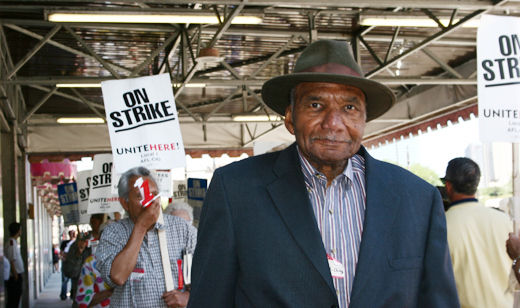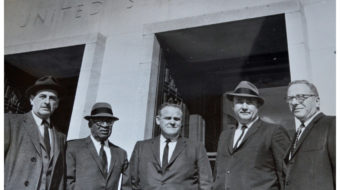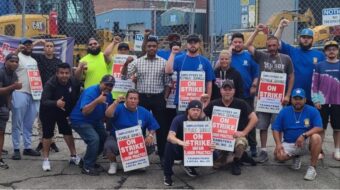
When my husband, Frank Lumpkin, went to work March 28, 1980 at Chicago’s Wisconsin Steel, 30 years after never missing a day at work, he found the gates locked in his face. I’m proud to say that Frank led the Wisconsin Steelworker’s fightback; it took nearly 17 years to win $19 million towards closing benefits. However, his mill was only one of many big plants and mills that closed soon after.
Not only did the Wisconsin steelworkers workers fight for their closing benefits, they also fought for the broad demands of the unemployed. Steelworkers joined workers from closed auto plants and other hard-hit areas to convene a National Congress of Unemployed in Chicago. With the demand “Jobs or Income Now,” JOIN, they collected thousands of signatures to Congress to ask for a Jobs Act. Congressman Charles Hayes, the only labor leader then in Congress, introduced the Income and Jobs Action Act of 1985. Today, when we hear the Poor People Campaign’s demand of “Guaranteed Basic Income,” we are reminded of Jobs or Income Now.
Still another demand of the unemployed of the 1980s is coming to the fore again with the Blue-Green Alliance. Add jobs by creating public works projects to rebuild the infrastructure. This important program has recently been upgraded by adding a demand for green jobs. Initiated by the United Steelworkers and Sierra Club, many unions and community groups are now members of the Blue-Green Alliance. But we have yet to renew the fight for a shorter work week, although workers in the United States work a longer work week by far than in any other industrial country.
At least 134 countries have laws setting the maximum length of the work week; the U.S. does not. In this country, 85.8 percent of males and 66.5 percent of females work more than 40 hours per week. Some estimates give 47 hours as the average work week here for full-time workers.
According to the ILO, “Americans work 137 more hours per year than Japanese workers, 260 more hours per year than British workers, and 499 more hours per year than French workers.”
We also have fewer protections as the only industrialized nation in the world that has no laws setting a maximum length for the work week, nor requiring any paid parental leave or paid vacation time.
Meanwhile, there have been huge increases in productivity resulting from improved technology. Clearly, more wealth is being created with fewer workers. But over 90 percent of the new wealth is going only to the very rich. As Bernie Sanders point out, “There is something profoundly wrong when the top one-tenth of one percent owns almost as much wealth as the bottom 90 percent.”

In the 1980s, it was greatly feared that what was then being called the “chip and robot revolution” would eliminate jobs. And it did. Hundreds of local union presidents issued a call for a “Shorter Work Week with No Cut in Pay.” In fact, this movement of local union presidents led to AFL-CIO President George Meany’s calling the largest labor march ever—the 1981 Solidarity Day March against President Ronald Reagan’s policies.
Today, advances in artificial intelligence and machine learning are creating an even greater labor-saving revolution. Shorter Week with No Cut in Pay is the only logical response. Sure, we also demand a guaranteed income, but workers want to work and have the right to a job.
I believe that the program that Frank Lumpkin fought for in the 1980s applies today. As he put it,
“If one man can do the work of ten men, why are we still working eight hours a day? We should work only six hours, four hours, whatever it takes to have jobs for everybody so everyone can make a living.”
Perhaps little is said about the lengthened work week because paychecks are going up. “No,” says Pew Research Center: “For most U.S. workers, real wages have barely budged in decades.”
Clearly, workers in our country are grossly underpaid and highly exploited. And they are also overworked. A fight for a shorter work week is vital. It is key to the fight for jobs and to protect workers from the perceived threat of robots operated with artificial intelligence and machine learning.
To close, a few interesting statistics:
At least 134 countries have laws setting the maximum length of the work week; the U.S. does not.
In the U.S., 85.8 percent of males and 66.5 percent of females work more than 40 hours per week.
According to the ILO, “Americans work 137 more hours per year than Japanese workers, 260 more hours per year than British workers, and 499 more hours per year than French workers.”









